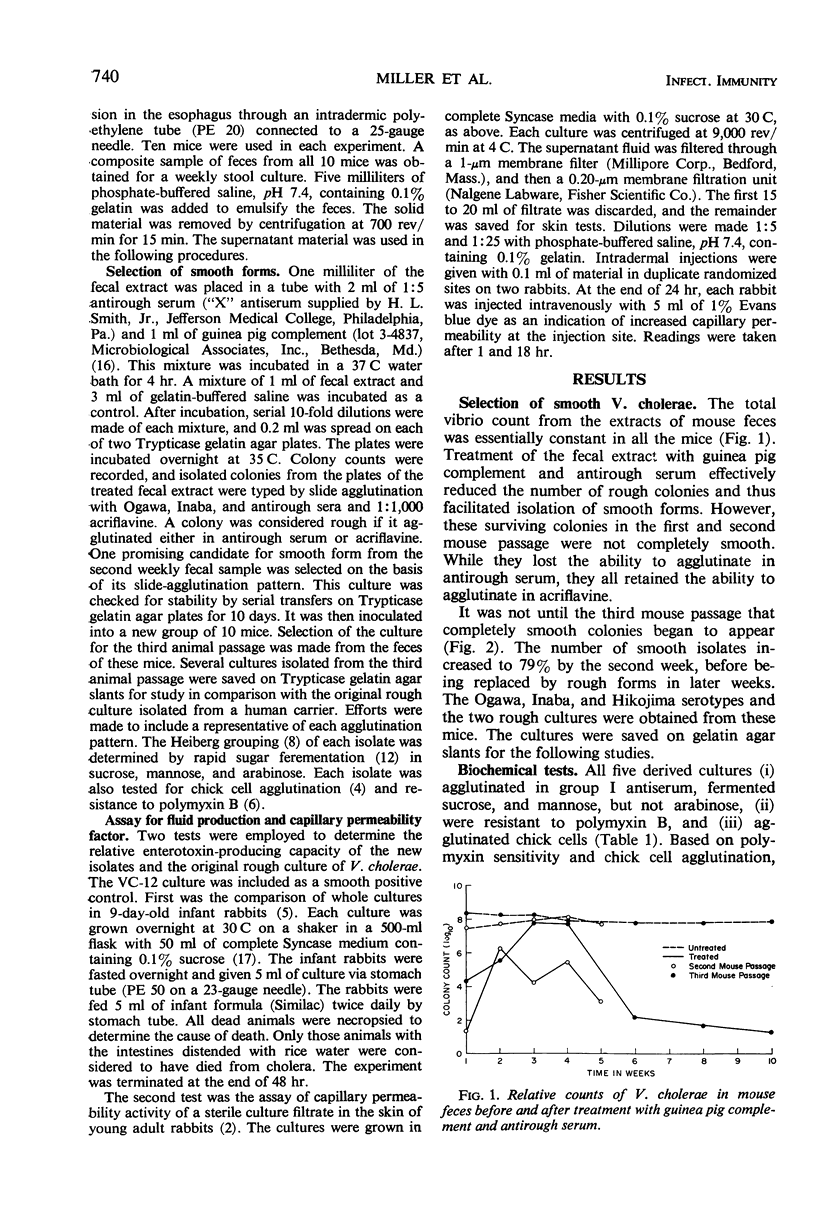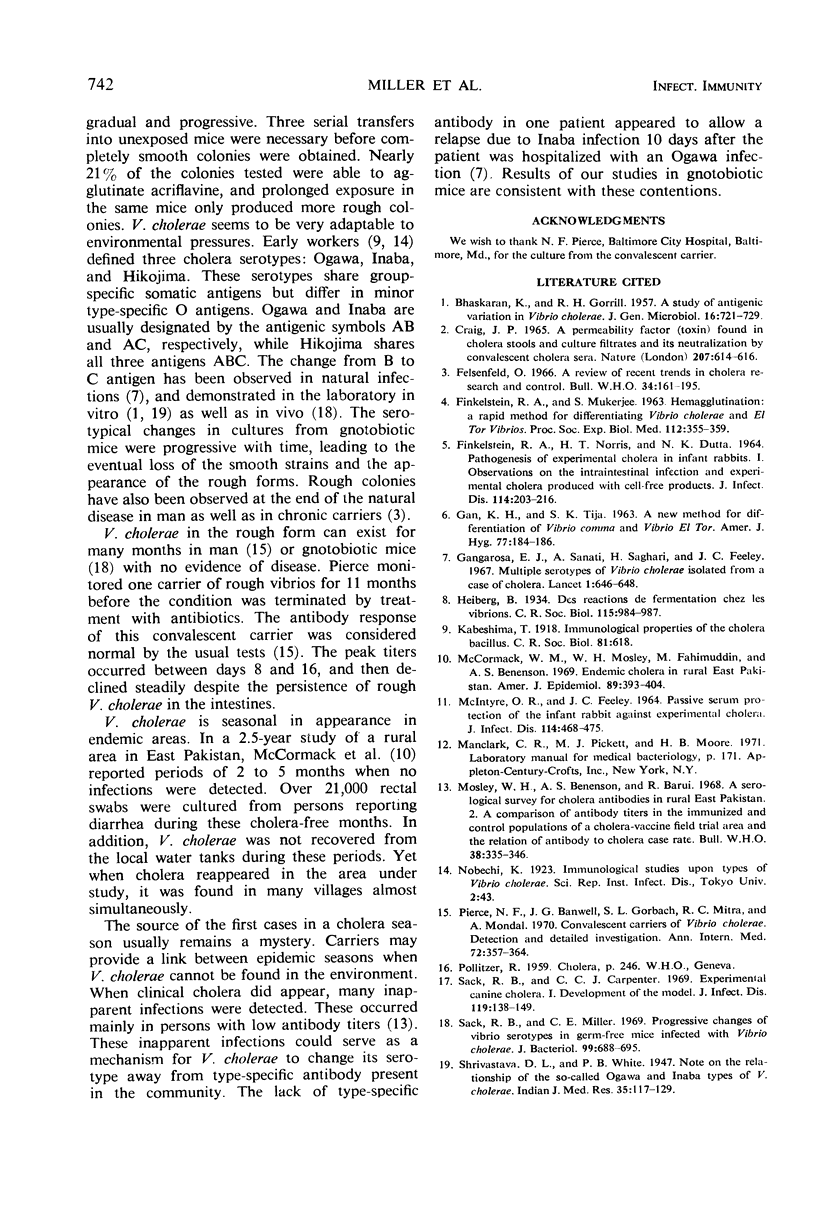Abstract
Cholera vibrios grow readily in the intestines of gnotobiotic mice and change their antigenic structure in response to immunological pressures. These changes were progressive, with the rough form persisting as the apparent end point in the mice. Inoculation of the rough form into fresh gnotobiotic mice resulted in the recovery of smooth forms. An untypable rough strain of Vibrio cholerae isolated from a chronic carrier in Calcutta in 1967 was passed serially in gnotobiotic mice. Smooth strains of V. cholerae were recovered from the feces after selective treatment with complement and antiserum against a rough strain. They were confirmed as O group I cholera vibrios belonging to the eltor biotype. The ability of these strains to produce diarrheal fluid in infant rabbits and to increase capillary permeability in rabbit skin was markedly increased over that of the original human isolate. This demonstrates that rough avirulent forms of V. cholerae from human carriers can undergo antigenic changes and concurrently increase in virulence when placed in an appropriate environment. The many inapparent cholera infections in endemic areas may provide a mechanism by which V. cholerae changes its serotype away from the immunological pressures in the population.
Full text
PDF



Selected References
These references are in PubMed. This may not be the complete list of references from this article.
- BHASKARAN K., GORRILL R. H. A study of antigenic variation in Vibrio cholerae. J Gen Microbiol. 1957 Jun;16(3):721–729. doi: 10.1099/00221287-16-3-721. [DOI] [PubMed] [Google Scholar]
- Craig J. P. A permeability factor (toxin) found in cholera stools and culture filtrates and its neutralization by convalescent cholera sera. Nature. 1965 Aug 7;207(997):614–616. doi: 10.1038/207614a0. [DOI] [PubMed] [Google Scholar]
- FINKELSTEIN R. A., NORRIS H. T., DUTTA N. K. PATHOGENESIS EXPERIMENTAL CHOLERA IN INFANT RABBITS. I. OBSERVATIONS ON THE INTRAINTESTINAL INFECTION AND EXPERIMENTAL CHOLERA PRODUCED WITH CELL-FREE PRODUCTS. J Infect Dis. 1964 Jun;114:203–216. doi: 10.1093/infdis/114.3.203. [DOI] [PubMed] [Google Scholar]
- Felsenfeld O. A review of recent trends in cholera research and control. With an annex on the isolation and identification of cholera vibrios. Bull World Health Organ. 1966;34(2):161–195. [PMC free article] [PubMed] [Google Scholar]
- Gangarosa E. J., Sanati A., Saghari H., Feeley J. C. Multiple serotypes of vibrio cholerae isolated from a case of cholera. Evidence suggesting in-vivo mutation. Lancet. 1967 Mar 25;1(7491):646–648. doi: 10.1016/s0140-6736(67)92542-1. [DOI] [PubMed] [Google Scholar]
- HAN G. K., KHIE T. S. A new method for the differentiation of Vibrio comma and Vibrio El Tor. Am J Hyg. 1963 Mar;77:184–186. doi: 10.1093/oxfordjournals.aje.a120308. [DOI] [PubMed] [Google Scholar]
- MCINTYRE O. R., FEELEY J. C. PASSIVE SERUM PROTECTION OF THE INFANT RABBIT AGAINST EXPERIMENTAL CHOLERA. J Infect Dis. 1964 Dec;114:468–475. doi: 10.1093/infdis/114.5.468. [DOI] [PubMed] [Google Scholar]
- McCormack W. M., Mosley W. H., Fahimuddin M., Benenson A. S. Endemic cholera in rural East Pakistan. Am J Epidemiol. 1969 Apr;89(4):393–404. doi: 10.1093/oxfordjournals.aje.a120953. [DOI] [PubMed] [Google Scholar]
- Mosley W. H., Benenson A. S., Barui R. A serological survey for cholera antibodies in rural east Pakistan. 2. A comparison of antibody titres in the innunized and control populationd of a cholera-vaccine field-trial area and the relation of antibody titre to cholera case rate. Bull World Health Organ. 1968;38(3):335–346. [PMC free article] [PubMed] [Google Scholar]
- Pierce N. F., Banwell J. G., Gorbach S. L., Mitra R. C., Mondal A. Convalescent carriers of Vibrio cholerae. Detection and detailed investigation. Ann Intern Med. 1970 Mar;72(3):357–364. doi: 10.7326/0003-4819-72-3-357. [DOI] [PubMed] [Google Scholar]
- Sack R. B., Carpenter C. C. Experimental canine cholera. I. Development of the model. J Infect Dis. 1969 Feb;119(2):138–149. doi: 10.1093/infdis/119.2.138. [DOI] [PubMed] [Google Scholar]
- Sack R. B., Miller C. E. Progressive changes of Vibrio serotypes in germ-free mice infected with Vibrio cholerae. J Bacteriol. 1969 Sep;99(3):688–695. doi: 10.1128/jb.99.3.688-695.1969. [DOI] [PMC free article] [PubMed] [Google Scholar]


